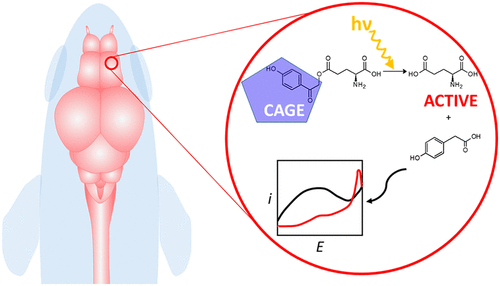当前位置:
X-MOL 学术
›
Anal. Chem.
›
论文详情
Our official English website, www.x-mol.net, welcomes your feedback! (Note: you will need to create a separate account there.)
In Situ Electrochemical Monitoring of Caged Compound Photochemistry: An Internal Actinometer for Substrate Release
Analytical Chemistry ( IF 7.4 ) Pub Date : 2021-01-25 , DOI: 10.1021/acs.analchem.0c03452 Romana Jarosova 1, 2 , Sam V Kaplan 1 , Thomas M Field 1 , Richard S Givens 1 , Sanjeewa N Senadheera 3 , Michael A Johnson 1, 4
Analytical Chemistry ( IF 7.4 ) Pub Date : 2021-01-25 , DOI: 10.1021/acs.analchem.0c03452 Romana Jarosova 1, 2 , Sam V Kaplan 1 , Thomas M Field 1 , Richard S Givens 1 , Sanjeewa N Senadheera 3 , Michael A Johnson 1, 4
Affiliation

|
Caged compounds are molecules that release a protective substrate to free a biologically active substrate upon treatment with light of sufficient energy and duration. A notable limitation of this approach is difficulty in determining the degree of photoactivation in tissues or opaque solutions because light reaching the desired location is obstructed. Here, we have addressed this issue by developing an in situ electrochemical method in which the amount of caged molecule photorelease is determined by fast-scan cyclic voltammetry (FSCV) at carbon-fiber microelectrodes. Using p-hydroxyphenyl glutamate (pHP-Glu) as our model system, we generated a linear calibration curve for oxidation of 4-hydroxyphenylacetic acid (4HPAA), the group from which the glutamate molecule leaves, up to a concentration of 1000 μM. Moreover, we are able to correct for the presence of residual pHP-Glu in solution as well as the light artifact that is produced. A corrected calibration curve was constructed by photoactivation of pHP-Glu in a 3 μL photoreaction vessel and subsequent analysis by high-performance liquid chromatography. This approach has yielded a linear relationship between 4HPAA concentration and oxidation current, allowing the determination of released glutamate independent of the amount of light reaching the chromophore. Moreover, we have successfully validated the newly developed method by in situ measurement in a whole, intact zebrafish brain. This work demonstrates for the first time the in situ electrochemical monitoring of caged compound photochemistry in brain tissue with FSCV, thus facilitating analyses of neuronal function.
中文翻译:

笼状化合物光化学的原位电化学监测:用于底物释放的内部光度计
笼状化合物是在用足够能量和持续时间的光处理时释放保护性底物以释放生物活性底物的分子。这种方法的一个显着限制是难以确定组织或不透明溶液中的光活化程度,因为到达所需位置的光被阻挡。在这里,我们通过开发原位电化学方法解决了这个问题,在该方法中,笼形分子光释放的量由碳纤维微电极上的快速扫描循环伏安法 (FSCV) 确定。使用对羟基苯谷氨酸(pHP-Glu) 作为我们的模型系统,我们生成了 4-羟基苯乙酸 (4HPAA) 氧化的线性校准曲线,4-羟基苯乙酸 (4HPAA) 是谷氨酸分子离开的基团,浓度高达 1000 μM。此外,我们能够纠正溶液中残留p HP-Glu 的存在以及产生的光伪影。通过在 3 μL 光反应容器中对 p HP-Glu 进行光活化并随后通过高效液相色谱分析来构建校正的校准曲线。这种方法在 4HPAA 浓度和氧化电流之间产生了线性关系,允许测定释放的谷氨酸,而与到达发色团的光量无关。此外,我们通过以下方法成功验证了新开发的方法在整个完整的斑马鱼大脑中进行原位测量。这项工作首次展示了用 FSCV 对脑组织中的笼状化合物光化学进行原位电化学监测,从而促进神经元功能的分析。
更新日期:2021-02-09
中文翻译:

笼状化合物光化学的原位电化学监测:用于底物释放的内部光度计
笼状化合物是在用足够能量和持续时间的光处理时释放保护性底物以释放生物活性底物的分子。这种方法的一个显着限制是难以确定组织或不透明溶液中的光活化程度,因为到达所需位置的光被阻挡。在这里,我们通过开发原位电化学方法解决了这个问题,在该方法中,笼形分子光释放的量由碳纤维微电极上的快速扫描循环伏安法 (FSCV) 确定。使用对羟基苯谷氨酸(pHP-Glu) 作为我们的模型系统,我们生成了 4-羟基苯乙酸 (4HPAA) 氧化的线性校准曲线,4-羟基苯乙酸 (4HPAA) 是谷氨酸分子离开的基团,浓度高达 1000 μM。此外,我们能够纠正溶液中残留p HP-Glu 的存在以及产生的光伪影。通过在 3 μL 光反应容器中对 p HP-Glu 进行光活化并随后通过高效液相色谱分析来构建校正的校准曲线。这种方法在 4HPAA 浓度和氧化电流之间产生了线性关系,允许测定释放的谷氨酸,而与到达发色团的光量无关。此外,我们通过以下方法成功验证了新开发的方法在整个完整的斑马鱼大脑中进行原位测量。这项工作首次展示了用 FSCV 对脑组织中的笼状化合物光化学进行原位电化学监测,从而促进神经元功能的分析。


























 京公网安备 11010802027423号
京公网安备 11010802027423号